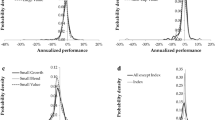Abstract
This article investigates whether a mutual fund’s performance is related to its herding behavior. Using the methodology of Sias (Rev Finance Stud 17:165–206, 2004), we develop a measure to capture the magnitude that a fund’s buy (sell) decisions are leading other funds’ buys (sells), and find that a fund’s performance is positively (negatively) related to its “buy leading” (“sell leading”). We interpret these findings as evidence that “buy leaders” (“sell leaders”)’ performance benefits (suffers) from the positive (negative) price effect associated with buy (sell) herds. Additionally, we find a positive relationship between fund performance and valuation-motivated “buy leading”, while we find weak evidence on the relationship between performance and valuation-motivated “sell leading”. We interpret these results as evidence that leading funds’ outperformance is due, in part, to their ability to value stocks.
Similar content being viewed by others
Notes
For reasons of brevity, we only discuss the evidence when we restrict our sample to stocks with at least 5 traders. Nevertheless, the evidence is similar when we restrict our sample to stocks with at least 2 traders, or 10 traders, respectively.
For the remainder of our analysis, we will use the classification criteria from Panel C to identify funds as buyers and/or sellers. We also performed the analysis using the criteria used in Panels A, and B, respectively, and the results are similar and available upon request.
Since we are interested in the relationship between a fund’s buy-leading (sell-leading) and its performance, we focus only on stocks that will be part of the fund’s portfolio following the trade decision. Consequently, we do not include terminating sells in our analysis.
Please see Daniel et al. (1997) for details on estimating CS alpha. The DGTW benchmarks are available via http://www.smith.umd.edu/faculty/rwermers/ftpsite/Dgtw/coverpage.htm.
References
Alexander GJ, Cici G, Gibson S (2007) Does motivation matter when assessing trade performance? An analysis of mutual funds. Rev Financ Stud 20:125–150
Brown NC, Wei KD, Wermers R (2014) Analyst recommendations, mutual fund herding, and overreaction in stock prices. Manag Sci 60:1–20
Choi N, Sias RW (2009) Institutional industry herding. J Financ Econ 94:469–491
Coval J, Stafford E (2007) Asset fire sales (and purchases) in equity markets. J Financ Econ 86:479–512
Daniel K, Grinblatt M, Titman S, Wermers R (1997) Measuring mutual fund performance with characteristics-based benchmarks. J Finance 52:1035–1058
Dasgupta A, Prat A, Verardo M (2011) Institutional trade persistence and long-term equity returns. J Finance 66:635–653
Edelen RM (1999) Investor flows and the assessed performance of open-end mutual funds. J Financ Econ 53:439–466
Frijns B, Lai Q, Tourani-Rad A (2014) Institutional trading and stock returns: evidence from China. Rev Pac Basin Finance Mark Policies 17:1–26
Gavriilidis K, Kallinterakis V, Leite-Ferreira MP (2013) Institutional industry herding: intentional or s purious? J Int Financ Mark Inst Money 26:192–214
Grinblatt M, Titman S, Wermers R (1995) Momentum investment strategies, portfolio performance, and herding: a study of mutual fund behavior. Am Econ Rev 85:1088–1105
Gutierrez RC, Kelley E (2009) Institutional herding and future stock returns. Working paper, University of Oregon and University of Arizona
Hoitash R, Krishnan M (2008) Herding, momentum and investor over-reaction. Rev Quant Finance Account 30:25–47
Holmes PR, Kallinterakis V, Leite Ferreira MP (2013) Herding in a concentrated market: a question of intent. Eur Financ Manag 19:497–520
Jiang H, Verardo M (2013) Does herding behavior reveal skill? An analysis of mutual fund performance. Working paper, Michigan State University and London School of Economics
Kacperczyk M, Sialm C, Zheng L (2008) Unobserved actions of mutual funds. Rev Financ Stud 21:2379–2416
Koch A (2016) The performance of leading, herding and following mutual fund managers. Manag Sci (forthcoming)
Lakonishok J, Shleifer A, Vishny RW (1992) The impact of institutional trading on stock prices. J Financ Econ 32:23–43
Popescu M, Xu Z (2014) Does reputation contribute to institutional herding? J Financ Res 37:295–322
Popescu M, Xu Z (2017) Mutual fund herding and reputational concerns. J Econ Finance (forthcoming)
Puckett A, Yan XS (2008) Short-term institutional herding and its impact on stock prices. Working paper, University of Missouri and University of Tennessee
Rakowski D (2010) Fund flow volatility and performance. J Financ Quant Anal 45:223–237
Rohleder M, Schulte D, Wilkens M (2017) Management of flow risk in mutual funds. Rev Quant Finance Account 48:31–56
Sias RW (2004) Institutional herding. Rev Financ Stud 17:165–206
Singh V (2013) Did institutions herd during the internet bubble? Rev Quant Finance Account 41:513–534
Voronkova S, Bohl MT (2005) Institutional traders’ behavior in an emerging stock market: empirical evidence on polish pension fund investors. J Bus Finance Account 32:1537–1560
Walter A, Weber M (2006) Herding in the German mutual fund industry. Eur Financ Manag 12:375–406
Wermers R (1999) Mutual fund herding and the impact on stock prices. J Finance 54:581–622
Wylie S (2005) Fund manager herding: a test of the accuracy of empirical results using UK data. J Bus 78:381–403
Acknowledgements
The authors are extremely grateful to Rick Sias for his comments on an earlier version of the paper and to seminar participants at Northeastern University.
Author information
Authors and Affiliations
Corresponding author
Rights and permissions
About this article
Cite this article
Popescu, M., Xu, Z. Leading the herd: evidence from mutual funds’ buy and sell decisions. Rev Quant Finan Acc 50, 1131–1146 (2018). https://doi.org/10.1007/s11156-017-0656-7
Published:
Issue Date:
DOI: https://doi.org/10.1007/s11156-017-0656-7



